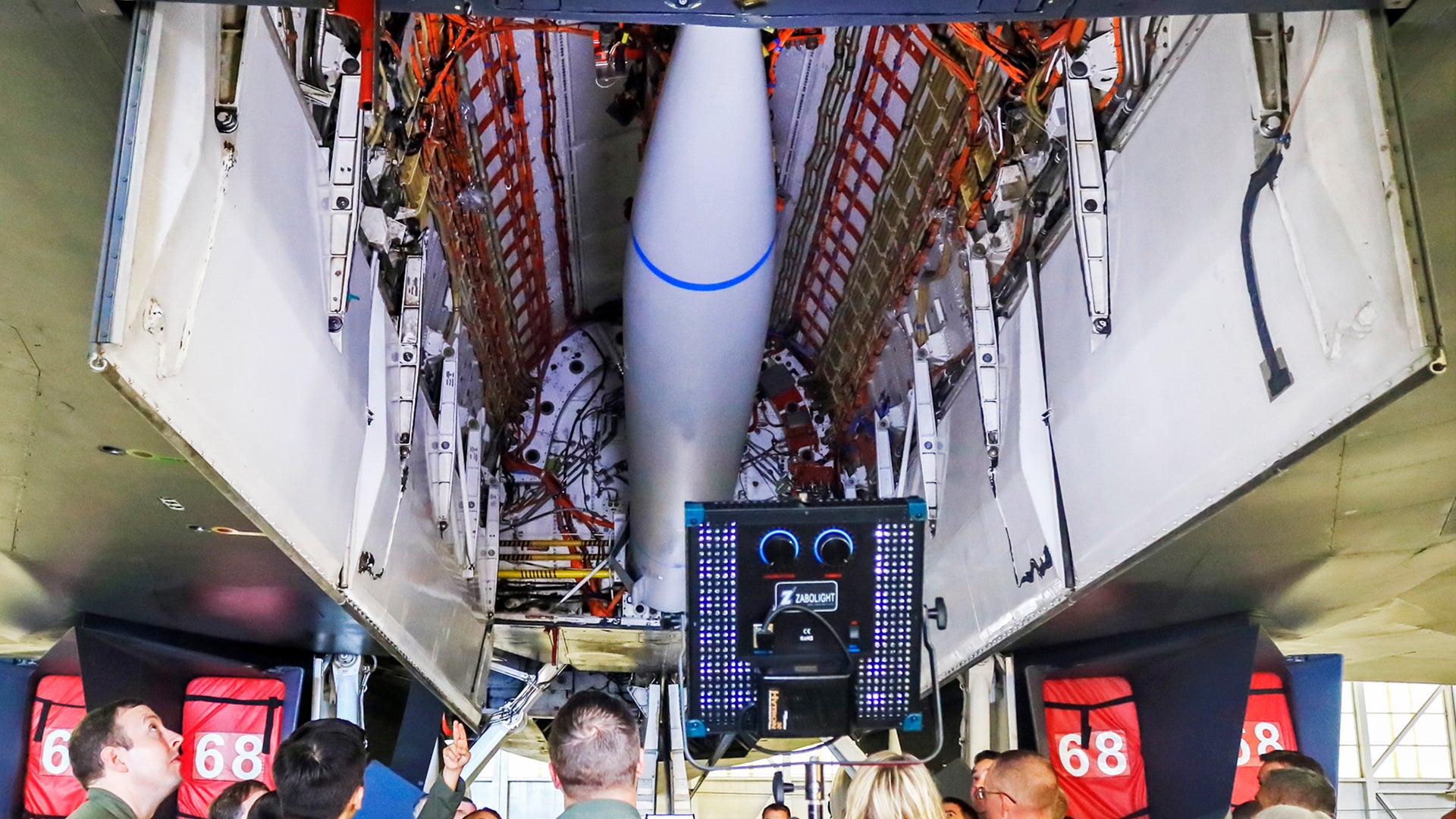The B-1B fleet may be tired and war wary after constant deployments overseas, but the USAF is continuing to look at how to improve the aircraft’s combat punch as it enters the back end of its career. This goes far beyond adding new avionics to its flight deck, new sensors, and communications gear. The flying force is now exploring ways to give the heavy-hitting Bone even more magazine capacity than it already has and the ability to carry outsized hypersonic missiles in its internal weapons bay.
The core of these exploratory efforts is centered around two latent features that were built into the swing-wing bomber’s design many decades ago. The B-1B was built with external hardpoints to carry large nuclear-tipped cruise missiles. These hardpoints were never really activated in a significant manner operationally, that is aside from the one under its right ‘neck’ area that it has used to mount the Sniper Advanced Targeting pod in recent years. The cruise missile racks themselves were pulled out of service completely following the B-1B losing its nuclear delivery role due to the START treaty.
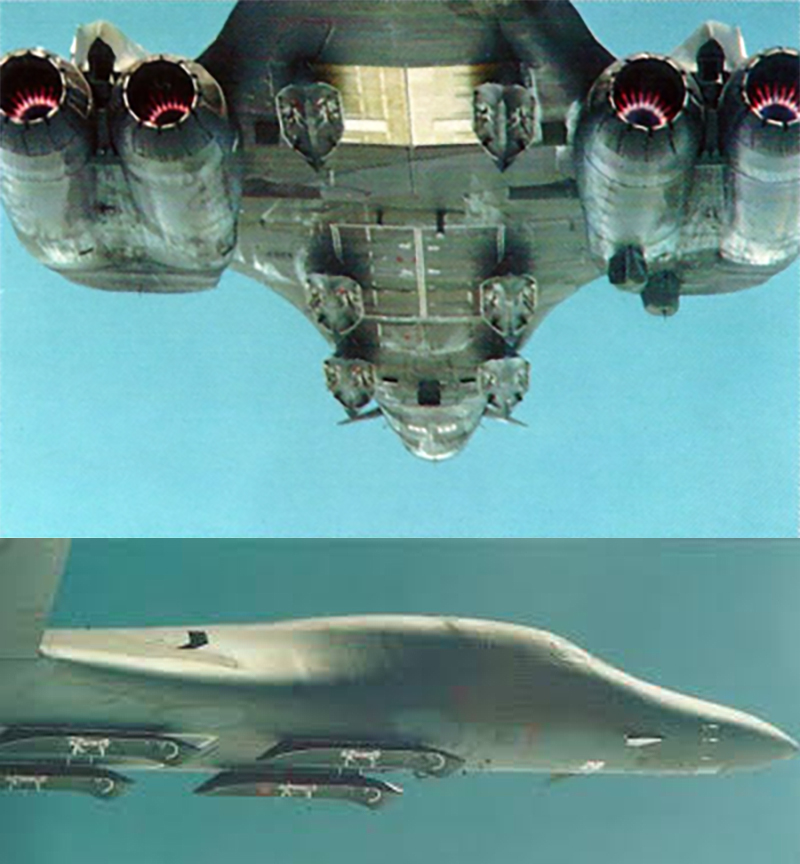
By introducing new racks for these pylons, the B-1B could carry even more weaponry than it currently does, and weapons of shapes and sizes that are not conducive to the dimensional confines of its internal weapons bays.
As for that internal weapons bay—actually, the Bone has three—the front two are connected by a common bulkhead that can be repositioned in order to create a much larger continuous bay. Doing so could allow for the carriage of large hypersonic missiles that require big boosters to get their vehicles up to speed and altitude. Currently, the B-52 is being allocated for the hypersonic weapons truck role, with external pylons specially engineered to weapons weighing tens of thousands of pounds. Yet the Bone’s potential ability to also carry these weapons, and do so internally, would add tremendous value to the aging and increasingly finicky to operate type.

All this and more was being put up for discussion at the 412th Test Wing and Global Strike Command’s “expanded carriage demonstration” that occurred on August 28th, 2019, at Edwards Air Force Base. At the gathering, industry partners were brought in to take a look at what the Air Force was thinking of for its middle-aged bomber in order to springboard development of these and other concepts centering on expanding the B-1B’s weapons carrying capability.
An Air Force news item about the show and tell session reads in part as follows:
“The purpose of the demonstration was to show that we’re still able to move the bulkhead from the forward intermediate bay to the forward location; increasing the intermediate bay capacity from 180 inches to 269 inches, said Lt. Col. Dominic Ross, B-1B program element monitor, AFGSC. “Additionally, we demonstrated that we can still carry weapons externally on six of the eight hard points, which increases our overall carriage capacity.”
“It increases the magazine capacity of the B-1B. Currently we can carry 24 weapons internally, now it can be increased to potentially 40 based on what type of pylon we would create,” Ross said. “This gets the B-1 into the larger weapons, the 5,000 pounders. It gets it into the hypersonics game as well.”
Ross said that the B-1B was designed with eight hard points to carry weapons, as well as a moveable bulkhead…
For the select industry partner open house of sorts, a B-1B was loaded-up with a mock-up hypersonic missile attached to the same smart bomb-capable Conventional Rotary Launcher now used in the B-52H’s weapons bay. In addition, a Joint Air-To-Surface Standoff Missile, also known as the AGM-158 JASSM, was attached to the same hardpoint that currently carries the Sniper Targeting pod as an example of how the Bone’s latent hardpoint attachments can be used to carry high-end weaponry. The JASSM and B-1B combination was the all-star of the multi-national cruise missile strikes on Syria in April of 2018.
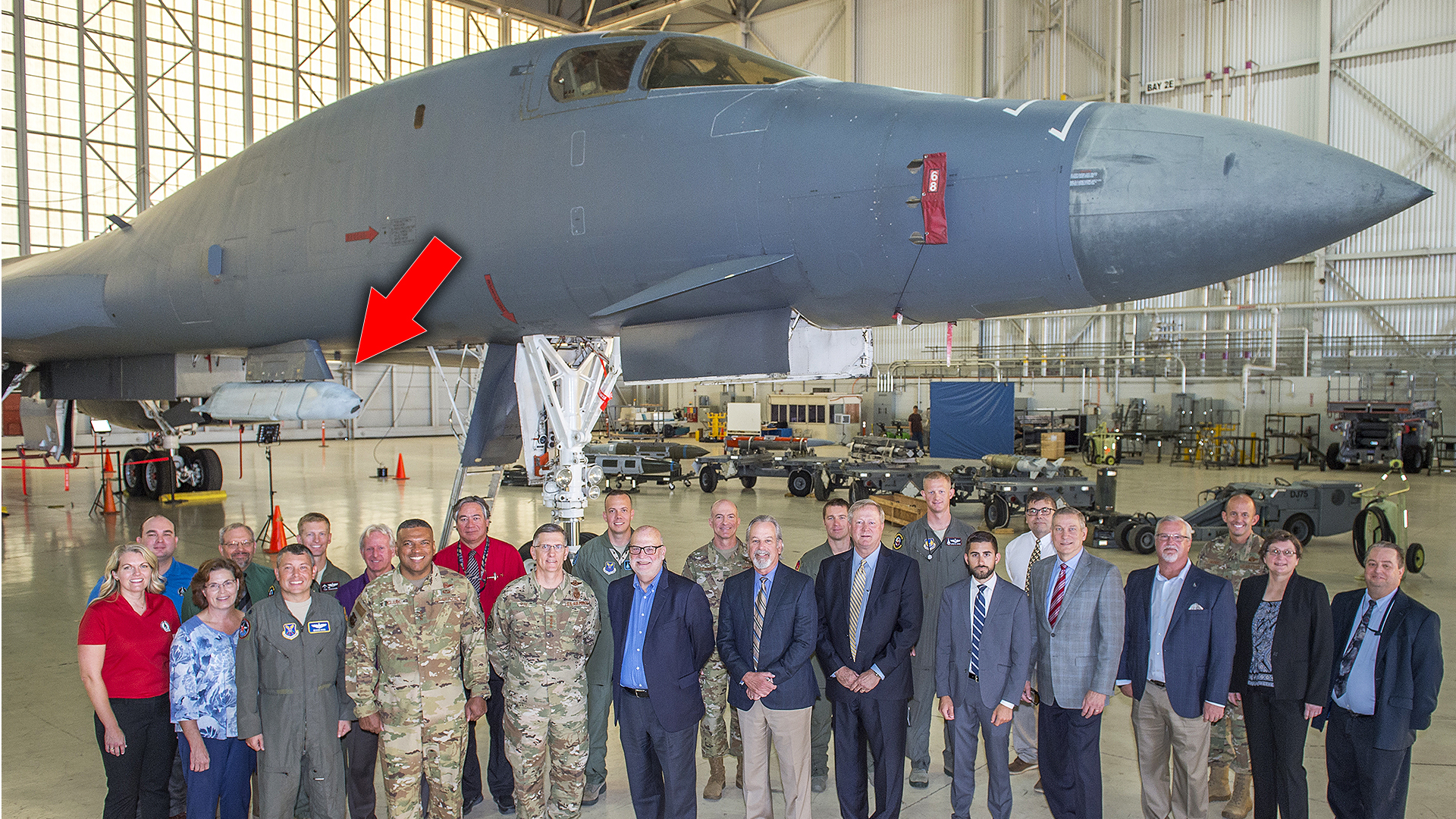
The Small Diameter Bomb II, also known as Stormbreaker, was also on display at the event. If it was integrated on the B-1B, it could potentially carry throngs of these all-weather precision glide bombs at one time. In some cases, this would allow the Bone lay waste to entire airfields, port facilities, armored formations, and other large target sets with pinpoint precision on a single pass, while also staying outside the heart of enemy air defenses.
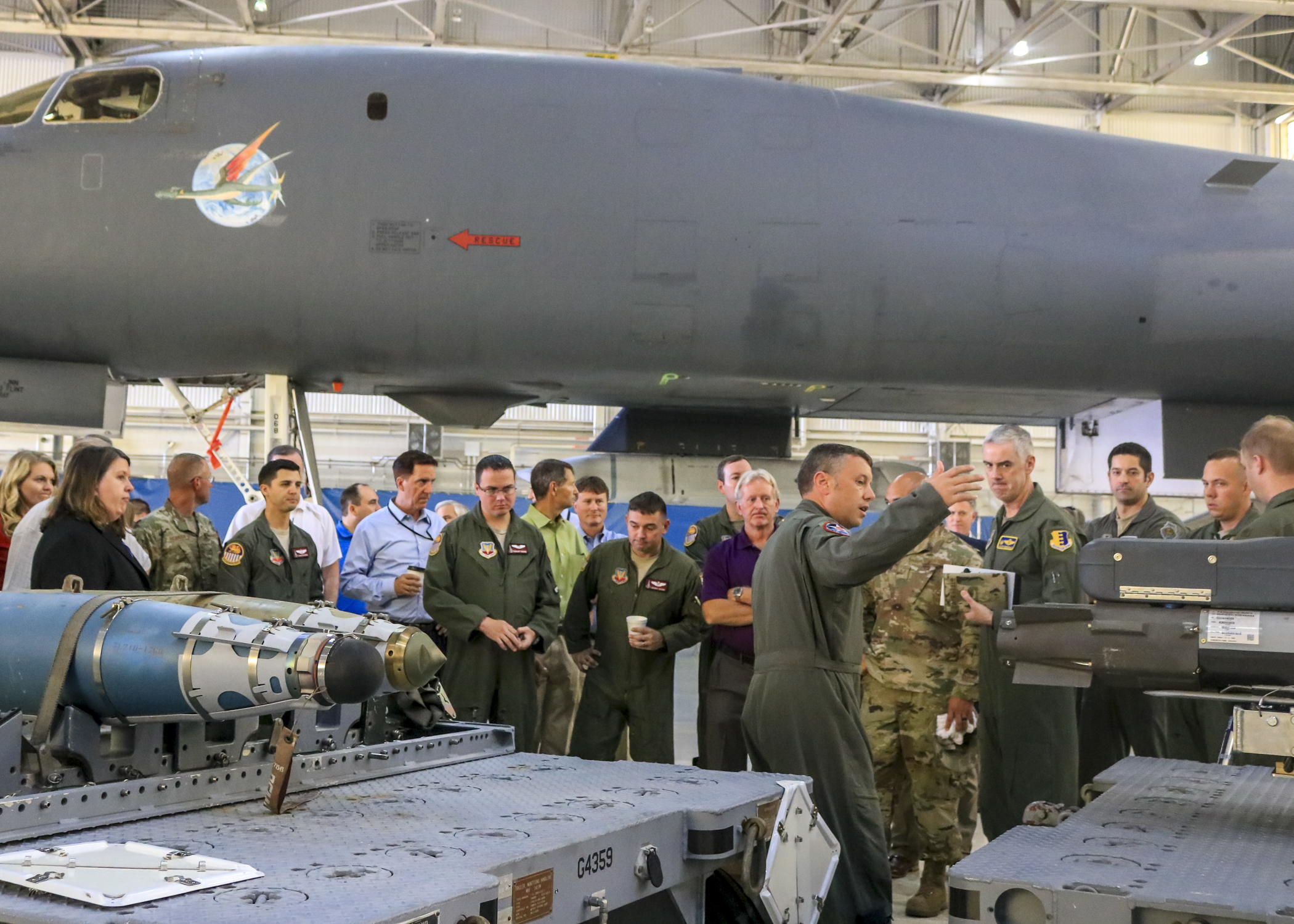
The Air Force news item continues:
Capt. Timothy Grace, test weapons systems officer, 419th FLTS, provided technical expertise about the B-1B aircraft used for the demonstration and was able to explain to the group how the proposed concept is relevant to the warfighter.
“I wanted to make sure it was tested correctly and reviewed it to make sure it’s relevant to the warfighter,” Grace said. “And absolutely, there are things we can use this for.”
Another point he made was how quickly the bulkhead modification can be accomplished, and then reversed.
“It’s not a permanent modification, it’s something that can be done through a few work shifts with the Maintenance (Flight),” he said. “So depending on what the targets are that we’re going after, the weapons we need to carry, we can move that bulkhead, and do the external carriage.”
From a commander’s viewpoint, the expanded carriage would open up better planning options, said Col. Richard Barksdale, 28th Operations Group commander, from Ellsworth AFB, South Dakota.
“It would basically increase the weapons capacity to make the bomber more efficient, so that we’re able to strike more targets with the same aircraft,” Barksdale said. “It would allow us to more efficiently plan for targeting and use fewer aircraft with fewer aircrews in harm’s way to strike the same number of targets. It would also decrease the support required, whether that’s tankers or other support assets.”
Barksdale compared the added capability to having “more arrows in the quiver of the B-1.”
“It really shows the aircraft was originally designed for that capability; to move that bulkhead forward and make a larger bay, it shows the forethought of the original engineers and now, that can potentially come into fruition,” Barksdale said. “To me, just the opportunity to increase the weapons load capacity is pretty exciting. It’s a pretty impressive capability.”
Ross said the initial idea was brought forth from B-1B crews, including himself. He previously served as a B-1B weapons systems officer, and then as a pilot.
This demonstration occurred at a very interesting time in the B-1B’s service life. During the Obama Administration, there was an initiative that looked to potentially convert the type into arsenal ship of sorts, loaded with a larger number and larger variety of precision-guided munitions, including long-range standoff weaponry. Before that, the B-1R supercruising region bomber upgrade was also floated, a potential initiative that also would have seen external stores stations be used operationally as mission requirements dictate. Neither of these programs came to fruition.
Fast forward to today and the B-1B fleet has found itself in an amazingly poor readiness condition. It has also been the source of headlines as of late due to systemic issues with critical life safety systems that have led to its grounding on multiple occasions for significantly long periods of time. The fleet is now being dug out of its dilapidated state by taking a much-needed pause in deployments, but its future remains, well, up in the air, to a certain degree.
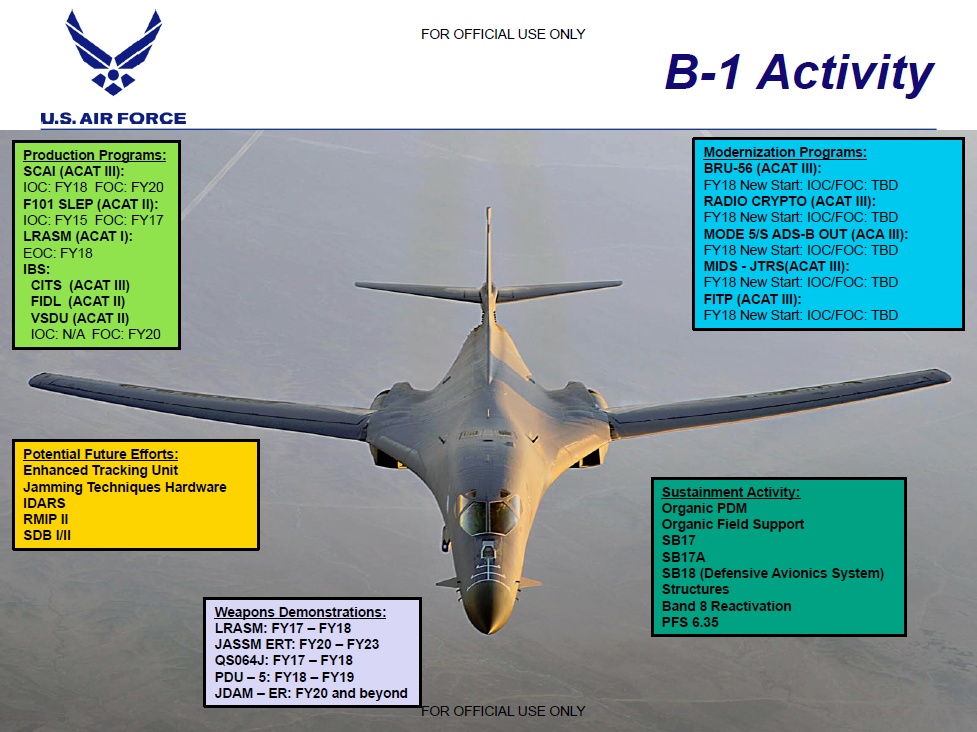
Even though it is slated to serve into the 2030s, at which time the B-21 Raider will replace it in full, just this week the USAF brass hinted that it will once again look to retire certain ‘legacy’ systems in order to free up funds for new weaponry and other initiatives. Of the bomber force, the B-1B is the only one at risk of being on the chopping block.
It will be interesting to see what comes of all this, but releasing the B-1B from the weapons carriage restrictions that are currently in place due to the configuration of its internal weapons bays may significantly change the Pentagon’s rationale for keeping it around in the short and long term. Also, being able to carry more weapons on external stations, and integrating smaller, but more numerous types, like Stormbreaker, may help provide that arsenal ship-like capability that was seen as so attractive just a few years ago.
In addition to JASSM, the B-1B is capable of employing its anti-ship cousin, the stealthy Long-Range Anti-Ship Missile, better known as LRASM. With more hardpoints, it could make the B-1B an even more capable stand-off anti-ship strike asset than it already is.
These features and the ability to haul around the USAF’s new golden child—hypersonic weapons—may just give the Bone the reprieve that it suddenly finds out it desperately needs.
Contact the author: Tyler@thedrive.com
